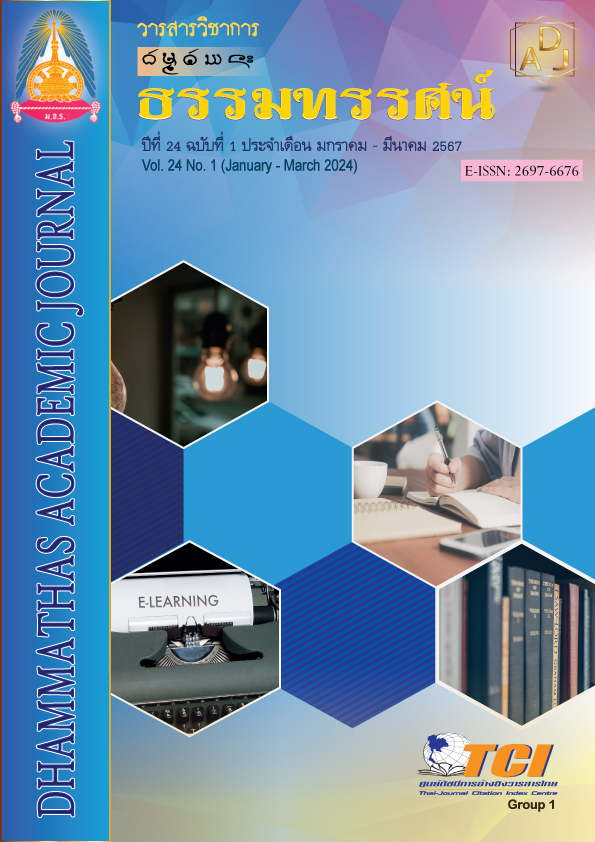Natural Resource Conservation Behavior of the People Living in the Wat Rai Khing Waterfront Community Nakhon Pathom Province
Main Article Content
Abstract
The purposes of this research were; 1) to study the attitudes towards natural resource conservation behavior among the residents of the riverside community near Wat Rai Khing, Nakhon Pathom province, and 2) examine the impact of residents' behavior on natural resource conservation in the riverside community near Wat Rai Khing, Nakhon Pathom province. It was a quantitative research study. The sample group used in the research consisted of residents living in the riverside community near Wat Rai Khing, Nakhon Pathom province, comprising 14 villages or 28 communities with a total population of 3,200 people. According to Yamane's formula, a sample group of 356 people was obtained. The research instruments included statistical questionnaires used for data analysis, including frequency, percentage, mean, standard deviation, and Pearson correlation coefficient.
The research findings were as follows:
1. The majority of respondents to the questionnaire were males aged between 31-40 years old, married, with education levels ranging from junior high school to vocational certificate, engaged in private businesses, and with an average monthly income of less than 35,000 baht.
2. Destructive behaviors towards natural resources, on average, were significantly high, including unsustainable occupations, the use of hazardous chemicals, and disturbance of aquatic and surrounding life. Overall, natural resource conservation behaviors were significantly high, including fostering understanding of environmental systems, efficient resource utilization, and addressing wastefulness and pollution resulting from human activities. Regarding hypothesis testing of personal factors with destructive behaviors towards natural resources and conservation behaviors, no significant differences were found in any aspect at a statistically significant level of 0.05.
Article Details

This work is licensed under a Creative Commons Attribution-NonCommercial-NoDerivatives 4.0 International License.
เพื่อให้เป็นไปตามกฎหมายลิขสิทธิ์ ผู้นิพนธ์ทุกท่านต้องลงลายมือชื่อในแบบฟอร์มใบมอบลิขสิทธิ์บทความ ให้แก่วารสารฯ พร้อมกับบทความต้นฉบับที่ได้แก้ไขครั้งสุดท้าย นอกจากนี้ ผู้นิพนธ์ทุกท่านต้องยืนยันว่าบทความ ต้นฉบับที่ส่งมาตีพิมพ์นั้น ได้ส่งมาตีพิมพ์เฉพาะในวารสาร วิชาการธรรม ทรรศน์ เพียงแห่งเดียวเท่านั้น หากมีการใช้ ภาพหรือตารางของผู้นิพนธ์อื่นที่ปรากฏในสิ่งตีพิมพ์อื่นมาแล้ว ผู้นิพนธ์ต้องขออนุญาตเจ้าของลิขสิทธิ์ก่อน พร้อมทั้ง แสดงหนังสือที่ได้รับการยินยอมต่อบรรณาธิการ ก่อนที่บทความจะได้รับการตีพิมพ์References
โกวิทย์ พวงงาม. (2553). การจัดการตนเองของชุมชนท้องถิ่น. กรุงเทพฯ: บพิธการพิมพ์.
ณัฐวุฒิ สุวรรณทิพย์ และคณะ. (2560). การสื่อสารการตลาดเชิงวัฒนธรรมเพื่อการอนุรักษ์ความหลากหลายทางศิลปวัฒนธรรมตลาดน้ำคลองแดน: ตลาดน้ำสามคลองสองเมืองของจังหวัดสงขลาและจังหวัดนครศรีธรรมราช. วารสารการจัดการสมัยใหม่, 15(2), 77-89.
พัลลภ หารุคำจา และคณะ. (2561). การอนุรักษ์ทรัพยากรธรรมชาติเชิงพุทธบูรณาการ: กรณีศึกษาการฟื้นฟูประเพณีแห่ช้างเผือกในพื้นที่ลุ่มน้ำลี้ จังหวัดลำพูน. วารสารวิทยาลัยสงฆ์นครลำปาง, 7(2), 35-42.
ภัทร ยืนยง และชนิตา รักษ์พลเมือง. (2558). การวิเคราะห์กระบวนการเรียนรู้ของขบวนการเคลื่อนไหวทางสังคมแบบใหม่ในการจัดการทรัพยากรธรรมชาติลุ่มน้ำโขง. วารสารครุศาสตร์, 43(4), 45-62.
รัศมี อุตเสนา. (2559). ตลาดน้ำกับการทำหน้าที่พัฒนาชุมชนอย่างยั่งยืน. วารสารวิชาการมหาวิทยาลัยอีสเทิร์นเอเชีย ฉบับสังคมศาสตร์และมนุษยศาสตร์, 6(3), 58-68.
วัดไร่ขิง. (2565). ข้อมูลทั่วไปเกี่ยวกับวัดไร่ขิง. เข้าถึงได้จาก https://raikhing.go.th/content.php?cid=20171030141514CTSkkA2
ศูนย์มานุษยวิทยาสิรินธร (องค์การมหาชน). (2565). ท่าพูดต่างมุมมอง. เข้าถึงได้จาก https://db.sac.or.th/museum/knowledge/40
อุบล วุฒิพรโสภณ และคณะ. (2565). การส่งเสริมวิสาหกิจชุมชนในการจัดตั้งตลาดริมน้ำวัดไร่ขิง เพื่อการท่องเที่ยวและเศรษฐกิจชุมชนอย่างยั่งยืน จังหวัดนครปฐม. วารสารปัญญาภิวัฒน์, 14(2), 118-132.
Yamane, T. (1973). Statistic: An introductory analysis. (3rd ed.). New York: Harper & Row.

